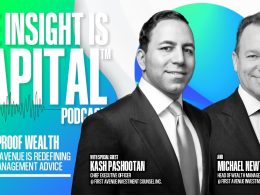E-Mything Your Financial Advisory Practice
by Maria Considine King, Commonwealth Financial Network
The E-Myth series by Michael Gerber has received acclaim for its down-to-earth presentation of the issues facing most small business owners. But what does it mean to "e-myth" your practice?
For you, as for most advisors, e-mything your financial advisory practice means stepping outside of your comfort zone as a technician and into your role as a CEO. It also means working on your business, rather than in it. You may consider yourself among the best financial advisors in the country, but this isn't going to ensure that your business will thrive.
So, what steps can you take to e-myth your practice—and what will the results be for you and your clients?
Two Kinds of Work
The reality is, you need to engage in two kinds of work. Gerber says the two kinds of work that small business owners do are strategic work and tactical work.
Strategic work is internal; it's about what you want to do. Strategic work involves asking some key questions:
- Why am I a financial professional?
- What will success look like? What will it feel like?
- What will my business look like when it's "done"?
- When do I want it to be "done"?
Strategic work designs your business; it's the work of an entrepreneur. This work can be difficult because the answers aren't always clear. But if you don't do it, you won't have a business—you'll just have a job.
Tactical work is the process of implementing what your strategic work designs. It is external and what you need to do. Simply put, it is the "job." Tactical work is easy because it's what you've excelled at for years.
When you're very good at doing the tactical work, you might assume that you know how to run a business that does the tactical work. But Gerber calls this the fatal assumption—"if you understand the technical work of a business, you understand a business that does that technical work."
Think Like an Entrepreneur
How can you think like an entrepreneur, rather than a technician? Gerber says to look at the processes that deliver your products. The value of your business lies in these processes.
It's no secret that the delivery of financial advice is becoming more commoditized. So, what differentiates you from other advisors? Is it the product? I would argue that it is the process and—by extraction—the experience your clients have of working with you through your process.
But how do you ensure that the experience of your business is consistently reliable for all who come into contact with it? The answer: vision. Your vision takes shape through planning, which Gerber says is the most important strategic work to begin doing—and to never cease doing.
Plans Vs. Planning
There is a maxim credited to Dwight D. Eisenhower: "In battle, I found plans to be useless but planning to be indispensable." What's the difference?
A plan is static. Planning, on the other hand, is dynamic. It is responsive to your environment. Planning anticipates change and keeps your mind agile. As you plan, questions to ask yourself include:
- Who are we?
- What do we do?
- How do we do it?
Step 1: Define your personal vision. Personal vision is the keystone to your business. Everything you do and everything you produce should be harmonious and support this vision.
Step 2: Articulate a vision for your business. The business you create should be one that contributes significantly to achieving your personal vision.
- What do you want your business to look like, to feel like, and to contribute to your life and the lives of your clients and community?
- Who are your clients?
- Why do your clients buy your services?
To help answer these questions, create your ideal client profile. You can also develop a written marketing plan to focus your efforts around this profile, allowing everyone in your practice to understand your strategy for reaching new clients. Further, a marketing plan geared toward your best clients (and prospects) will help ensure that you communicate with your target niche in an effective manner.
Systems Bring Your Business to Life
After defining your business and your clients, focus on your systems, which can bring everything to life. These systems deliver your value proposition on a regular, reliable basis.
When I say systems, you might think of technology. But technology is effective only to the extent that it supports well-articulated processes with clear deliverables. Instead, think in terms of three other kinds of systems:
- Hard systems are tangible tools that communicate your values (e.g., your desktop, phone, printer, and the appearance of your office).
- Soft systems communicate your values in a softer manner (e.g., processes for acquiring clients, holding client reviews, networking, and reviewing staff performance).
- Information systems or metrics include the number of appointments, number of A clients, assets under management, client survey results, and so forth.
These systems work together to deliver your value proposition to clients, as well as to strengthen your culture and value system within the business. To ensure they remain responsive to the evolving needs of your business, be sure to assess and refine your systems regularly.
Manage the Process (Not the People)
The next step is managing the process, not the people. After all, people don't want to be managed. They do want to belong to something important—that is, your business and the processes that define it. So, manage the processes by focusing on the results that you and your staff are striving to achieve:
- Can improvements be made?
- Are sufficient resources given to the process?
Try to involve staff in process evaluations, encouraging them to think about how their efforts contribute to the growth of your firm. You might find that growth strategies boil down to goals that are articulated in terms of money. With this in mind, consider using bonuses as an incentive for staff who play a role in growing your firm. The key is to link those bonuses to goals that your staff can directly control.
The Role of Money
Money plays a big role in every business. According to Gerber, money serves four business functions:
- Income: This is the money you get paid for doing tactical work.
- Profit: Is it intentional or accidental? Profit includes investment capital, bonus capital, operating capital, and return on investment for the owner who is taking the risk.
- Flow: What money does in your business.
- Equity: The value a prospective buyer puts on your business.
Be clear about how money functions in your business. Ask yourself, when your business is "done," what will it bring to you in financial terms when you sell it? If you don't plan on retiring, what will it bring to your heirs?
Of course, it might be a long time before your business is "done." But there is one certainty about the passage of time: Things will change.
Be Unreasonable
Change is internal, not external. It's something you choose to do, not something imposed upon you. Change is a process rather than an end in and of itself. Remember the maxim attributed to Eisenhower? Planning—that key activity that targets opportunities—also anticipates change. That anticipation keeps your mind agile, constantly asking, "What if?"
In closing, I'd like you to think about this quote from George Bernard Shaw: "The reasonable man adapts himself to the world; the unreasonable one persists in trying to adapt the world to himself. Therefore, all progress depends on the unreasonable man."
Be unreasonable.
Do you subscribe to Gerber's thoughts on e-mything your financial advisory practice? Do you see how it could help you differentiate yourself from other advisors? Please share your thoughts with us below.
Commonwealth Financial Network is the nation’s largest privately held independent broker/dealer-RIA. This post originally appeared on Commonwealth Independent Advisor, the firm’s corporate blog.
Copyright © Commonwealth Financial Network
















